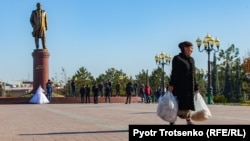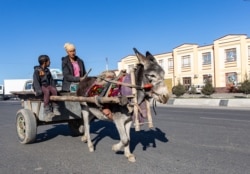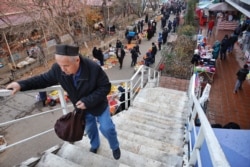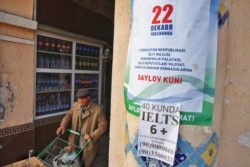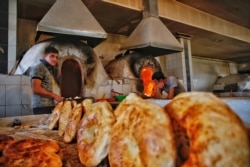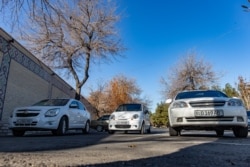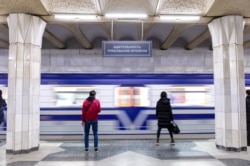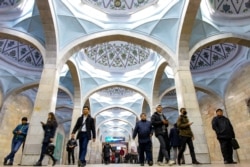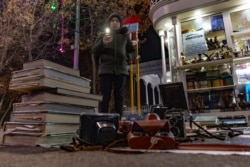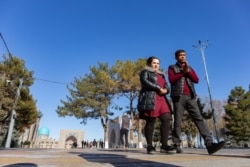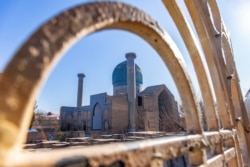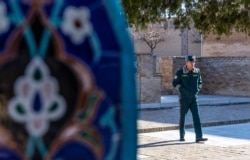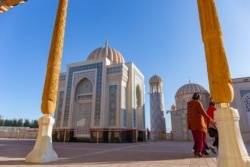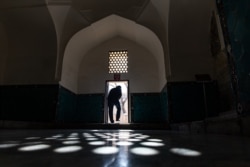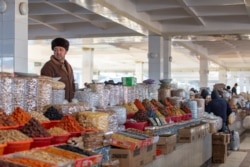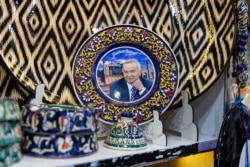Three years ago, Uzbekistan went through its first major political upheaval in decades. The death of Islam Karimov, who had ruled the country since it gained independence in 1991, was announced in September 2016. Two months later, the prime minister, Shavkat Mirziyoev, was elected president with an overwhelming majority.
The transition prompted debate inside and outside Uzbekistan as to whether the country was headed for a political thaw or a continuation of an autocratic regime under different leadership. Since 2016, there have been slow but visible signs of change: Foreign investment and tourism are growing, and Uzbeks are able to travel abroad without official permission.
Pyotr Trotsenko, a correspondent for RFE/RL’s Kazakh Service, known locally as Radio Azattyq, traveled through Uzbekistan in November to investigate the shifting landscape. He spoke with Uzbeks about the changes they’ve witnessed and whether they hold out hope for greater transformations.
Rising Prices And Growing Opportunities In Tashkent
The train from Almaty to Tashkent was stuck at the border for hours. “Your passport, please,” said a stocky Uzbek border guard before closely inspecting my documents. He confirmed that everything was in order, then made way for another guard with a dog on a leash.
“Open the bag. What do you have? Are there any prohibited medicines? Psychoactive drugs?”
He inspected the train compartment. Finally, we set off for Tashkent, less than an hour away.
At the station, we were surrounded by taxi drivers, but locals advised me not to use their services. They said it was cheaper and safer to use Yandex.Taxi, the app-based service owned by a Russian Internet giant. As I caught a ride with a driver named Mahmud, he told me that competition in his field had grown in the past three years.
“Yes, a lot has changed,” he said. “Yandex.Taxi appeared last year. There’s a lot of construction throughout the city. They’re building houses and shopping centers. By the end of the shift, my whole car is covered with dust from construction sites. Prices have gone up, of course. The price of gasoline has increased a lot. So a lot of people are using [compressed natural gas]. It turns out to be cheaper.”
Mahmud said that along with rising prices, there have also been growing opportunities for work. There are more tourists, especially in summer, and foreigners, primarily Chinese, are coming to Uzbekistan for jobs.
“Of course, there were a lot of tourists under Karimov, but since then there have been even more,” Mahmud said. “Right now, there’s almost nobody. The season is over. But there are a lot of Chinese. I have five rides a day with them. People say they’re coming here to work. I’ve already learned how to say hello in their language.”
Coffee Culture In The Capital
In the center of Tashkent, I met with a young businessman named Dilmurod (who asked me not to use his real name). The 25-year-old was working on plans to open a coffee delivery service in Tashkent with his friends. He said that business opportunities have expanded significantly, with new brands and franchises arriving in the country.
“There’s been a big boon to urban businesses,” Dilmurod said. “We’re going to open our business as a chain. Coffee in Tashkent is just becoming fashionable, and the market is still open. We’ve made our business plan, and it looks like it can be very profitable.”
Dilmurod pointed out that foreign travel has also grown easier. Uzbekistan abolished its requirement for exit visas at the beginning of 2019 and stopped questioning citizens who returned from abroad.
“My friends had to deal with this. They left the country for some time, and when they came back, the security services interrogated them: where they went and why, who they met, what they did abroad.” Dilmurod said that such interrogations still take place, but much less often.
Dilmurod drives around Tashkent in an Uzbek-made Chevrolet -- practically the only model of car we see on the roads. Imported cars are subject to tariffs that can reach 30 percent of their cost, so most drivers are limited to buying vehicles manufactured in the country.
But there’s another option for getting around Tashkent: the ornate Soviet-era metro system. In 2018, authorities lifted a ban on taking photos inside the subway, allowing outsiders to see the luxurious stations. The original cars dating back to the 1970s are gradually being replaced.
Security was high in the metro. Police were on duty at every station and signs in Russian and Uzbek warned passengers to stay vigilant. But residents told me that they felt safe under the close surveillance of police and video cameras.
Tashkent officials also use the metro for public outreach. Videos played on TV screens in the cars advertise the services of city health clinics, educational programs, and tourist attractions.
Dilmurod and I walked along Sayilgoh Street, a main drag known humorously as Broadway. Vendors selling food and souvenirs lined the sidewalks, side by side with dealers of Soviet artifacts like medals and busts of Lenin.
“A few years ago, there were no musicians here and people were forbidden from staying out late. They said it was to prevent crime and riots in the city center,” Dilmurod said. “In 2017, they allowed musicians again. Look how nice it’s become. There are places to eat now. Last year, the first KFC opened up.”
But Dilmurod said the positive changes he’s seen in Tashkent don’t necessarily extend to rural regions.
“Outside of Tashkent, people live the same way they always have,” he said. “I often travel to the regions to visit relatives or to work. People don’t have money. There are constant interruptions in electricity and gas supplies. But there are some changes even there. New houses are being built. There are some farmers who live better than urban workers. Those who have money try to buy apartments in Tashkent.”
Karimov’s Bejeweled Mausoleum
A fast train covers the 300 kilometers from Tashkent to Samarkand in two hours. The service on board, with polite attendants and breakfast, was similar to an airplane flight.
Samarkand is one of Uzbekistan’s main tourist destinations, and its appeal has only grown since 2016. After Islam Karimov was buried here, Uzbeks and foreigners began visiting his burial site.
A local guide, Shukhrat, took me to Karimov’s mausoleum. He stayed in the car during most of our visits to historical sites, explaining that he wanted to keep out of view of the tourism police.
“I don’t earn enough to pay taxes yet,” he said.
Karimov was buried on the grounds of the ancient Hazrat Khizr Mosque, a UNESCO heritage site. In 2018, a new white and green marble mausoleum was built over his grave. The interior was decorated with semiprecious stones.
Security forces kept visitors from lingering at the mausoleum and barked at anyone trying to take photos. I attempted to conceal my camera as I snapped a few shots.
Inside and outside the mausoleum, a recorded prayer could be heard playing from loudspeakers, with periodic mentions of Karimov’s name.
“A lot of people go to visit the grave. Not everyone managed to see him during his lifetime,” Shukhrat said. He pointed out the elaborate wood and stonework at the site, noting that no costs were spared.
Unlike most people I spoke to, Shukhrat was convinced that life was better in Karimov’s time.
“Food and gas prices were low,” he said. “Now everything is getting more expensive: power, gas, water, meat. I don’t know why it’s that way, but people are unhappy. And you can’t get angry about it. If you say something, they’ll put you in prison. You can’t criticize anything.”
Shukhrat said there was no shortage of jobs in Samarkand, but wages are low. He supports his family on $300 to $400 a month, but others earn less and many rely on multiple side jobs to try to make ends meet.
The number of tourists in Samarkand has almost doubled in recent years, and Shukhrat hopes that the trend will continue. There are plans under way to build a new international airport in the city within three years, allowing tourists to fly there directly from foreign cities.
Before leaving the city, Shukhrat took me to another attraction: the Samarkand bazaar. There was a wide array of fruits, nuts, and sweets, including specialties I’d never seen at Kazakh markets. Shukhrat offered to take me to his most trusted sellers, although it seemed that everyone offered the same goods at the same prices.
Souvenir shops at the bazaar offered robes, teapots, and huge platters for serving pilaf. But relatively few offered souvenirs with images of Karimov. We discovered one shop where his portrait appeared on a decorative plate, and another selling photos of the former ruler. The vendor suggested a picture of Karimov and Vladimir Putin. When he learned that I was from Kazakhstan, he reluctantly admitted that he had no pictures of former Kazakh President Nursultan Nazarbaev, who ruled for even longer than Karimov.
Shukhrat drove me to the station and encouraged me to visit again in spring, when I would see a city transformed by the seasons, not only by slow-moving political changes.




